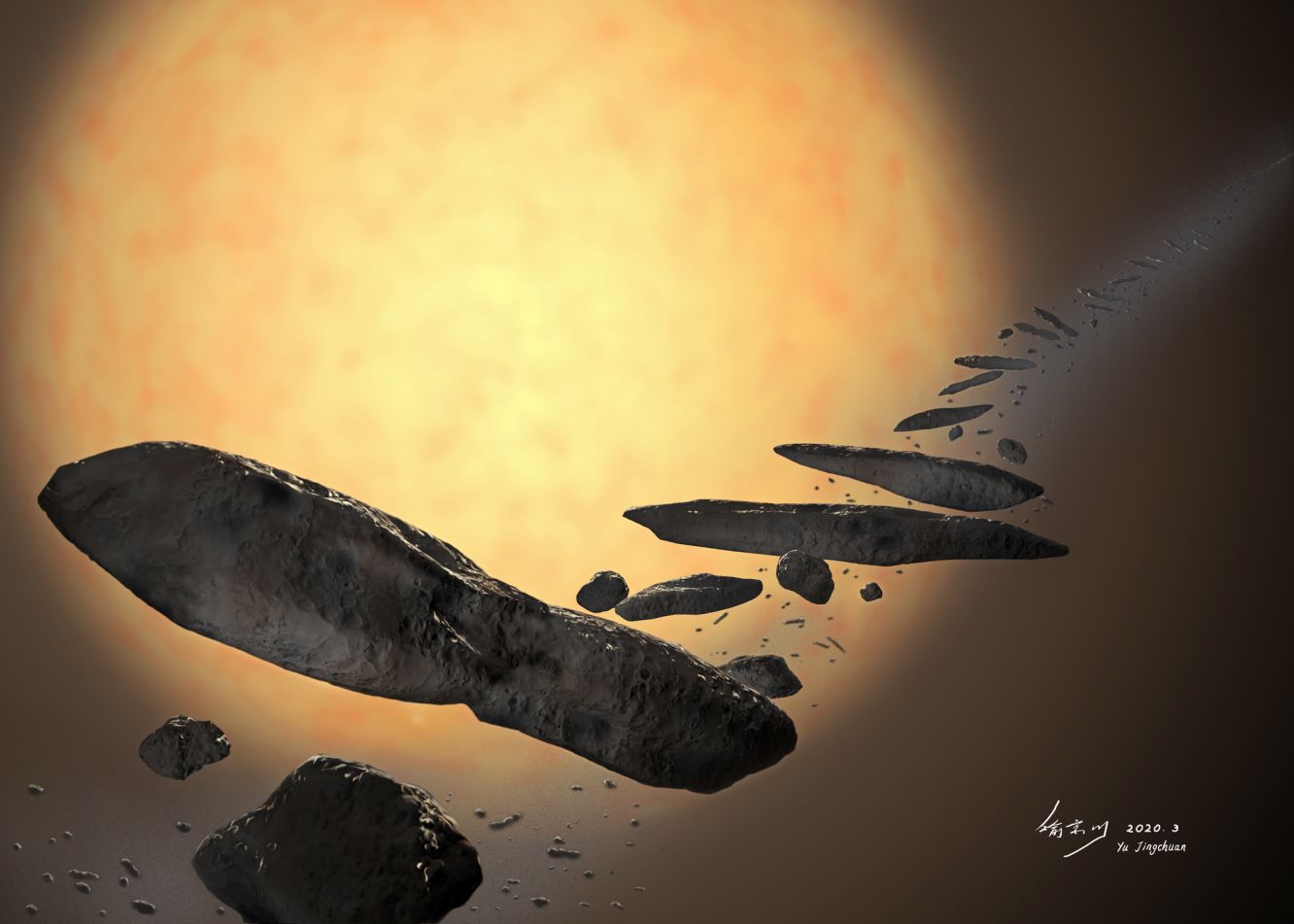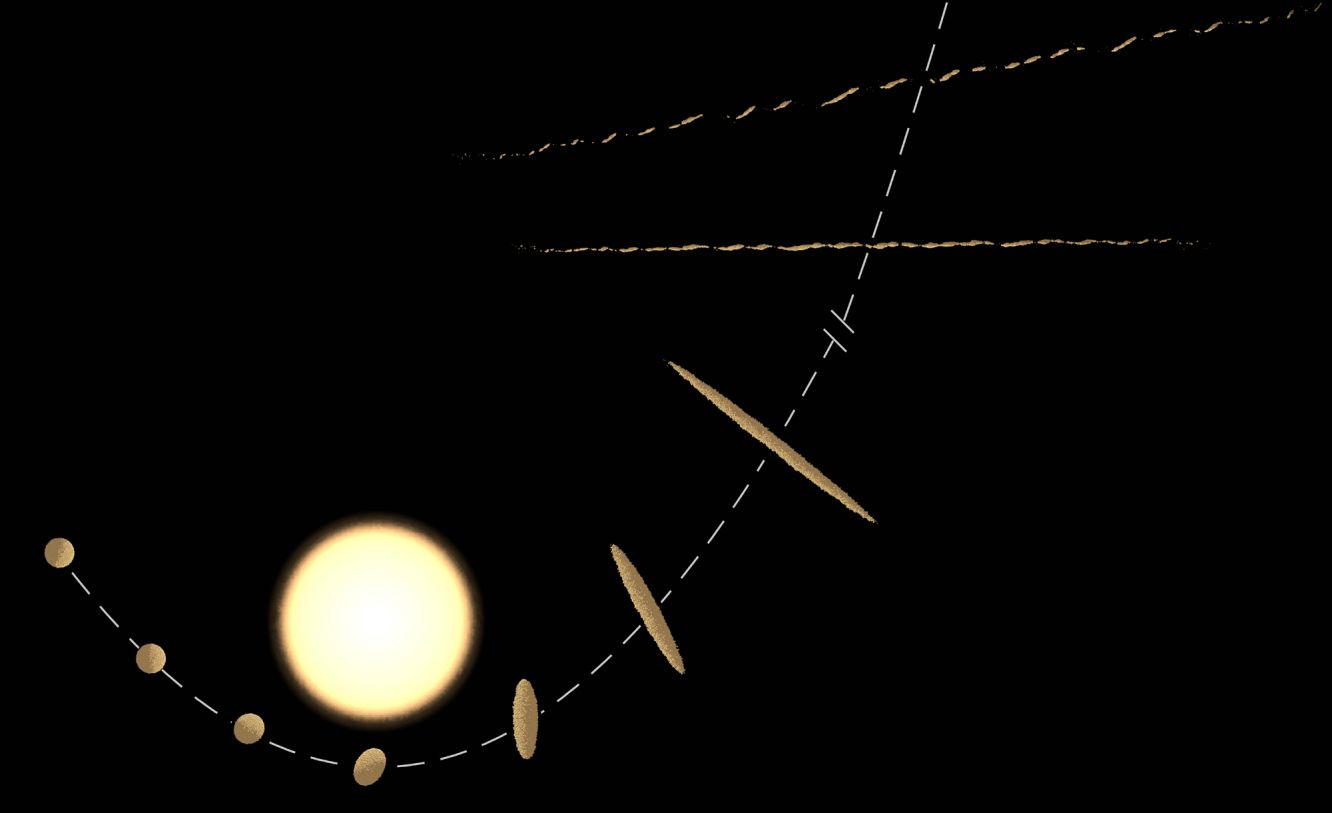
Our solar system's first known interstellar visitor may have a very violent origin story.
The mysterious object 'Oumuamua, which was spotted zooming through the inner solar system in October 2017, is probably a fragment of a larger body that was torn apart by gravitational forces during a close flyby of its native star, a new study suggests.
This "tidal fragmentation scenario not only provides a way to form one single 'Oumuamua but also accounts for the vast population of asteroid-like interstellar objects," lead author Yun Zhang, of the National Astronomical Observatories of the Chinese Academy of Sciences, said in a statement.
Related: 'Oumuamua: Our 1st interstellar visitor explained in photos
The hypothesis explains 'Oumuamua's weirdness as well, according to Zhang and study co-author Douglas Lin, an astronomer at the University of California, Santa Cruz.
That weirdness is extreme and multilayered. For example, 'Oumuamua is highly elongated, like a big space cigar (and may be somewhat flattened as well). Astronomers had never before seen a cosmic object with that shape.
In addition, 'Oumuamua displayed "non-gravitational acceleration" during its trek through our neighborhood — motion that can't be attributed to tugs by the sun, Jupiter or other big bodies. Such motion can be caused by cometary outgassing, which pushes an object this way and that like thrusters on a spacecraft.
Get the world’s most fascinating discoveries delivered straight to your inbox.


But 'Oumuamua displayed no signs of outgassing — no visible tail or coma — even though most astronomers thought the interloper was likely to be a comet. (Comets tend to reside far from their host stars and are therefore easier to boot into interstellar space.)
Finally, detecting 'Oumuamua at all is odd, and quite informative. Considering how vast space is, how long it takes to cross interstellar gulfs and how half-hearted our hunt for such bodies has been thus far, stumbling onto even a single 'Oumuamua implies a truly huge population of similar objects.
"On average, each planetary system should eject in total about 100 trillion objects like 'Oumuamua," Zhang said.
This combination of characteristics has spurred some scientists — most prominently, Avi Loeb, who chairs Harvard University's astronomy department — to propose that 'Oumuamua might be an alien spacecraft. The available data are consistent with a light-sailing probe, perhaps a defunct one, Loeb has said, stressing that researchers should at least be open-minded about this possibility.
Related: Could life on Earth have come from another star system?
The new study, however, posits a natural explanation. Zhang and Lin used computer simulations to investigate how objects are affected by flybys of their native stars. This modeling work revealed that very close encounters can rip these bodies into elongated fragments, which are then ejected into interstellar space.
Extreme heating during the flyby and the cooling that follows it causes these fragments to develop a surface crust, which helps support and maintain their odd shape, the results further indicate.
"Heat diffusion during the stellar tidal disruption process also consumes large amounts of volatiles, which not only explains 'Oumuamua’s [reddish] surface colors and the absence of visible coma but also elucidates the inferred dryness of the interstellar population," Zhang said. ("Volatiles" are elements and compounds that are easily lost to space, such as water.)
“Nevertheless, some high-sublimation-temperature volatiles buried under the surface, like water ice, can remain in a condensed form," he added. These hidden volatiles could be "activated" during encounters with other stars like our sun, causing outgassing and non-gravitational acceleration, the researchers said.
The parent bodies of such interstellar objects are a diverse lot, suggests the new study, which was published online today (April 13) in the journal Nature Astronomy. The ejected fragments could be pieces of long-period comets, planetary building bodies or even "super-Earth" planets that strayed too close to their stars. (And those stars don't necessarily need to be alive; superdense stellar corpses known as white dwarfs could do the required disruption as well.)
"These interstellar objects could provide critical clues about how planetary systems form and evolve,” Zhang said.
'Oumuamua is not the only interstellar visitor we know about. In August 2019, astronomers spotted a second interloper, known as Comet Borisov (and it is quite clearly a comet). And they should start seeing many more such objects soon, especially after the Vera C. Rubin Observatory comes online in the mountains of Chile.
"'Oumuamua is just the tip of the iceberg," Lin said in the same statement.
Studying many more such objects may be our best bet to understand 'Oumuamua, which has long since sped out of sight into the dark depths of the outer solar system. (That said, sending a probe out to rendezvous with 'Oumuamua is not out of the question.)
"As future interstellar objects are discovered in coming years, it will be very interesting to see if any exhibit 'Oumuamua-like properties," U.S. Naval Academy astronomer Matthew Knight, co-leader of the ‘Oumuamua International Space Science Institute team, said in the same statement.
"If so, it may indicate that the processes described in this study are widespread," added Knight, who was not involved in the new study.
- Why was 'Oumuamua so weird? New research tries to track its origins.
- 'Oumuamua and Borisov are just the beginning of an interstellar object bonanza
- Interstellar comet: Here's why it's got scientists so pumped up
Mike Wall is the author of "Out There" (Grand Central Publishing, 2018; illustrated by Karl Tate), a book about the search for alien life. Follow him on Twitter @michaeldwall. Follow us on Twitter @Spacedotcom or Facebook.
OFFER: Save 45% on 'All About Space' 'How it Works' and 'All About History'!
For a limited time, you can take out a digital subscription to any of our best-selling science magazines for just $2.38 per month, or 45% off the standard price for the first three months.





